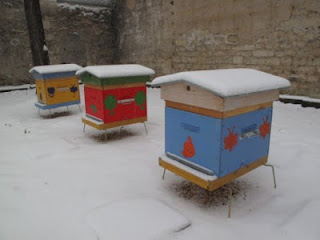This shot taken on Saturday morning shows Square du Temple - in an almost Caillebotte painting - in front of my friend's apartment. She lives to the left of the yellow umbrella'd playground slides - next to the townhouse on the upper floor.
But what about the bees in Paris?
What happens to the bees during the winter and how do they defend themselves from the cold?
When the thermometer goes below zero the bees in the more than 50 apiaries in Paris adopt a range of behaviors that enable the colony to spend the winter and grow again in the spring. They stockpile pollen and honey in the summer. Beekeepers estimate that it takes twenty pounds of honey in the hive at the entrance of the winter to cover the needs of the colony.
Here's the beehives on the roof of the Institute for the Deaf in the Latin Quarter. In the fall, the bees in the hive decrease from say 50,000 workers in May and June to 20 000 bees in December or January. That's a lot fewer mouths to feed. Winter bees with abundant fat reserves live about 6 months, gradually replacing the short-lived bees.

 Even more remarkable is how the bees warm each other and protect the queen. For this they get together, shake against each other to form a kind of ball known as the cluster. At the same time, they consume honey and vibrate their muscles like little helicopters. This produces heat which maintains the center of the cluster to a temperature close to 30 ° C. And a rotation similar to that of Emperor penguins forming a turtle on the ice to defend against blizzard. So within the cluster their heat radiates and all are warmed.
Even more remarkable is how the bees warm each other and protect the queen. For this they get together, shake against each other to form a kind of ball known as the cluster. At the same time, they consume honey and vibrate their muscles like little helicopters. This produces heat which maintains the center of the cluster to a temperature close to 30 ° C. And a rotation similar to that of Emperor penguins forming a turtle on the ice to defend against blizzard. So within the cluster their heat radiates and all are warmed.These hives are on top of Ma Tante - my aunt - which is the city run municipal pawn shop in the Marais. Duc d'Orleans, a brother of one of the kings, had gambled too much a few centuries ago resulting in an awkward situation with no Louis in his pocket. He disappeared for awhile saying he had to go to 'ma tante' actually cashing in a ring and returned to pay his debt and gamble more. From aristocrats to the poor, everyone, it's said, eventually visits their aunt one time.
These are the tilleul - lime - trees on the Marais street near ma tante which the bees frequent.
Cara- Tuesday



















Interesting post and lovely pictures.
ReplyDeleteAnn
That's a lovely post, Cara.
ReplyDeleteThanks Cozy and Tim. I'm fascinated by bees these days and all the honey produced and sold
ReplyDeletein Paris...more on that coming up.
From pussy cats in prison to bees in the snow packed Latin Quarter. WOW, I feel as if I'm tuned in to an urban safari channel--and loving it!
ReplyDelete